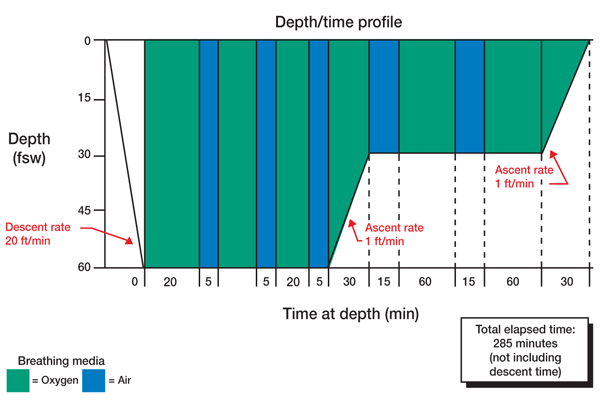 |
 |
- Search
| J Korean Med Assoc > Volume 55(7); 2012 > Article |
Abstract
Diving is a perilous activity. Long exposure to the subaquatic environment results in many troubles to divers. In Korea, the number of divers, especially recreational ones, is soaring up and the incidence of diving related accidents and illnesses is also increasing rapidly. Consequently, diving medicine which approaches underwater medical problems is getting more important to doctors as well as divers. Decompression sickness (DCS) is one of the most typical diseases in diving medicine, and divers who breathe compressed air or mixed gas always have a risk of suffering from it. DCS is caused by bubbles from dissolved inert gas as a result of decompression. The diagnosis of DCS is based completely on clinical manifestations, but it is not easy to make a correct diagnosis due to various symptoms. In general, DCS needs prompt recompression chamber treatment with trained medical and paramedical staff, but few doctors are trained to handle diving related diseases like DCS and most people in Korea are not aware of diving medicine. Additionally, lack of recompression facilities hinders DCS patients from taking treatment timely. To deal with these problems, Korean government as well as doctors needs to show deep concern at this field.
References
1. Pelletier JP. Recognizing sport diving injuries. Dimens Crit Care Nurs 2002;21:26-27.
2. Pollock NW, Dunford RG, Denoble PJ, Dovenbarger JA, Caruso JL. Annual diving report 2008 edition 2008;Durham: Divers Alert Network.
3. Oh KJ, Choi SW, Park JS, Lee SU. A study on hyperbaric chambers for treating decompression sickness in the republic of Korea. J Korean Soc Emerg Med 2011;22:253-258.
4. Spira A. Diving and marine medicine review part II: diving diseases. J Travel Med 1999;6:180-198.
5. Butler WP. Caisson disease during the construction of the Eads and Brooklyn Bridges: a review. Undersea Hyperb Med 2004;31:445-459.
6. Walker R. In: Edmonds C, Lowry C, Pennefather J, Walker R, editor. Decompression sickness: history and physiology. Diving and subaquatic medicine 2001;4th ed. London: Arnold. 111-130.
7. Kindwall EP. In: Bove AA, editor. A short history of diving and diving medicine. Bove and Davis' diving medicine 2004;4th ed. Philadelphia: Saunders. 1-9.
8. Spira A. Diving and marine medicine review part I: diving physics and physiology. J Travel Med 1999;6:32-44.
9. Levett DZ, Millar IL. Bubble trouble: a review of diving physiology and disease. Postgrad Med J 2008;84:571-578.
10. Foster PP, Butler BD. Decompression to altitude: assumptions, experimental evidence, and future directions. J Appl Physiol 2009;106:678-690.
11. Freiberger JJ, Denoble PJ, Pieper CF, Uguccioni DM, Pollock NW, Vann RD. The relative risk of decompression sickness during and after air travel following diving. Aviat Space Environ Med 2002;73:980-984.
12. Vann RD, Butler FK, Mitchell SJ, Moon RE. Decompression illness. Lancet 2011;377:153-164.
13. Sakong J. Diving patterns and diving related disease of diving fishermen in Korea. Korean J Prev Med 1998;31:139-156.
14. Oh KJ, Park JY, Sakong J. Diving patterns and decompression sickness related symtoms of SCUBA divers. Korean J Sports Med 2008;26:78-90.
15. Marroni A, Bennett PB, Cronje FJ, Cali-Corleo R, Germonpre P, Pieri M, Bonuccelli C, Balestra C. A deep stop during decompression from 82 fsw (25 m) significantly reduces bubbles and fast tissue gas tensions. Undersea Hyperb Med 2004;31:233-243.
16. Vann RD. In: Bove AA, editor. Mechanisms and risks of decompression. Bove and Davis' diving medicine 2004;4th ed. Philadelphia: Saunders. 127-164.
17. United States Naval Sea Systems Command. Diving medicine and recompression chamber operations. US Navy diving manual 2008;5:6th rev. Washington, DC: AquaPress.
18. Francis TJ, Pearson RR, Robertson AG, Hodgson M, Dutka AJ, Flynn ET. Central nervous system decompression sickness: latency of 1070 human cases. Undersea Biomed Res 1988;15:403-417.
19. Longphre JM, Denoble PJ, Moon RE, Vann RD, Freiberger JJ. First aid normobaric oxygen for the treatment of recreational diving injuries. Undersea Hyperb Med 2007;34:43-49.
20. James PB, Jain KK. In: Jain KK, editor. Decompression sickness. Textbook of hyperbaric medicine 2009;5th ed. Gottingen: Hogrefe. 87-102.
Figure 1
US Navy Treatment Table 6 (From United States Naval Sea Systems Command. US Navy diving manual. Washington, DC: AquaPress; 2008) [17]. fsw, feet sea water.

- TOOLS
-
METRICS

-
- 2 Crossref
- Scopus
- 1,332 View
- 11 Download
-
Related articles in
J Korean Med Assoc -
Why do suicide and depression occur?2012 April;55(4)
The contraindication of comedication drugs and drug utilization review2012 May;55(5)





